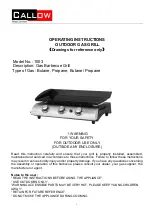
LEAK TESTING THE REGULATOR, VALVES, HOSES, AND CONNECTIONS
1. Ensure the LP cylinder valve and all burners are “Off”.
2. Ensure the LP cylinder is connected to the regulator.
3. If the information in 1 & 2 is not followed exactly, a fire causing death or serious injury may occur.
4. Mix a solution of 50% water and 50% liquid dish soap. Do not use any household cleaning
solution.
5. Open the LP tank valve by turning the hand wheel counterclockwise one turn. If you hear a
rushing sound, turn the gas off immediately. In that case, there could be a leak at the connection.
Reconnect the cylinder to the regulator.
6. Spray or brush on the solution covering the following areas: regulator and cylinder connection,
gas hose connections to the regulator, all gas hoses, all gas hose connections to the burners,
including the main and side burners.
7. Growing bubbles on any of the parts and connections listed above indicate a gas leak.
Immediately shut off the LP tank valve by turning the valve clockwise. Re-tighten the connections or
order replacement parts as needed. Continue to test as necessary until no leaks are detected.
8. Close the LP tank valve by turning the hand wheel clockwise.
WARNING
1. Do not connect this grill to any unregulated sources of propane.
2. Before each use, check the gas hose for excessive abrasion, wear, or cuts. Replace a hose
assembly showing those signs with the hose assembly specified in the parts list before using the
grill.
3. Always perform the Leak Test listed below before using your grill for the first time after the
cylinder has been changed, any gas components have been changed, the regulator flow-limiting
device has been activated, or after a long period of non-use.
4. Do not attempt to connect this grill to the LP system of a motor home or trailer.
WARNING
1.
DO NOT USE THE GRILL
if you cannot stop the leaks. Be sure the LP cylinder valve is
closed. If the LP cylinder is still leaking, contact your LP dealer or local fire department.
2. Do not use any match or open flame, or smoke, during leak testing.
3. Do not light a burner during leak testing.
4. The replacement hose assembly must be the one identified.


































